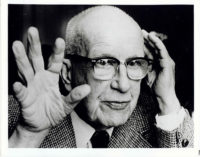Buckminster Fuller Challenge Launched

Buckminster Fuller Challenge Launched
Buckminster Fuller seen with a chrome-plated, bronze portrait bust of himself. Isamu Noguchi sculpted the bust over the course of seven sittings, during which he and Fuller forged a lifelong friendship, sharing ideas about art, science, and technology.
Photo by F.S. Lincoln, Courtesy The Isamu Noguchi Foundation and Garden Museum

Buckminster Fuller Challenge Launched
Buckminster Fuller’s Dymaxion Car #2 is the only one of three surviving prototypes of the vehicle he designed using models by Isamu Noguchi. Built between 1933 and 1934, the cars attained top speeds of 120 miles per hour and achieved a fuel efficiency level of 25 to 30 miles per gallon.
Photo Courtesy The Harrah Collection of the National Automobile Museum, Reno, Nevada

Buckminster Fuller Challenge Launched
During the 1940s, Fuller designed his Dymaxion House to be mass-produced, affordable, and environmentally efficient. The bulk of the structure was cantilevered from a tension-based central column mast. Despite preorders for the Dymaxion, it never went into production. The last surviving prototype is on display at the Henry Ford Museum.
Photo Courtesy The Henry Ford

Buckminster Fuller Challenge Launched
Isamu Noguchi seen with Buckminster Fuller.
Photo Courtesy the Estate of Arnold Eagle



